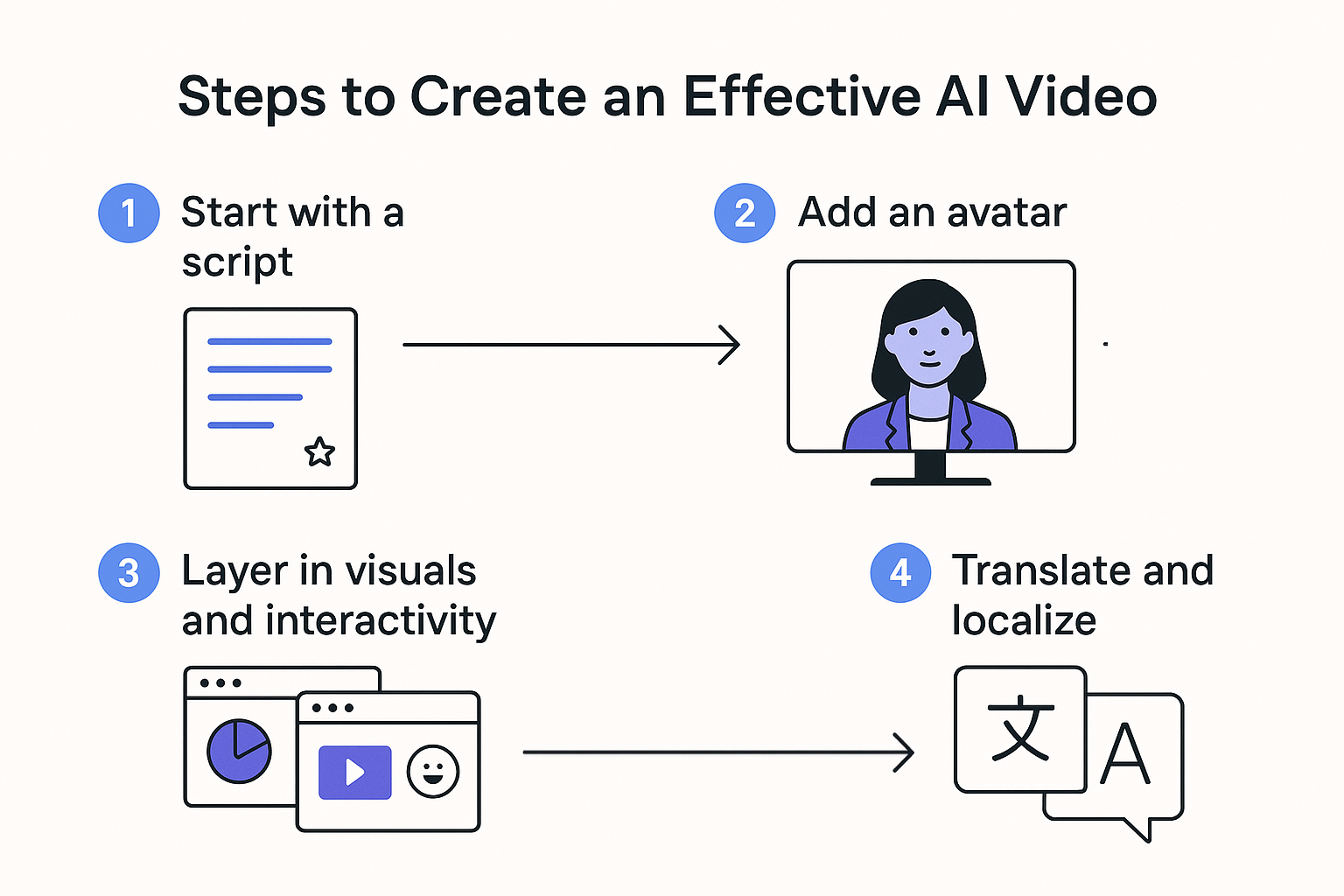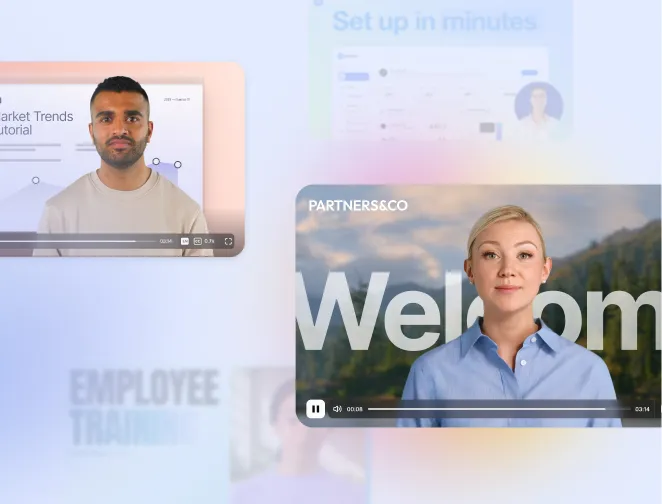
Speed vs. Quality vs. Cost: Rethinking Video Production in the Age of AI
Create AI videos with 230+ avatars in 140+ languages.
For years, video production has carried a reputation: complex, expensive, and reserved for only the most high-value communications. Think polished brand campaigns, product demos, or carefully crafted customer-facing assets.
Why?
Because traditional video required layers of people and expertise, scriptwriters, designers, video editors, brand and legal reviewers, subject-matter experts, all before the content ever reached an audience. The natural result: video became a premium medium, reserved for when "perfect" quality justified the investment.
But the ground has shifted. AI video creation is reshaping expectations, just as PowerPoint once did for presentations. Where once only designers and production experts could build professional decks, suddenly anyone with a laptop could spin up a presentation. Some were quick and rough, others polished and rehearsed. And that was okay, because not every presentation needed to be TED-worthy. Video is moving the same way.
Good Enough Beats Invisible
Here’s the trade-off that often gets missed: a medium-quality video is infinitely better than text nobody reads.

Instead of publishing yet another wiki page or document that gets buried, what if you created a quick video, something colleagues could watch during a commute, listen to while cooking, or play in the background? Engagement rises dramatically when information is delivered in a human, dynamic format.
AI video lowers the barrier so that anyone, not just professional creators, can generate something that’s good enough to capture attention. And when you compare it against the alternative (silence, ignored text, or clunky slides), the value is obvious.
Focus on the Core: Script and Content
The beauty of AI tools today is that you don’t have to start from scratch. Large Language Models (LLMs) can help draft scripts, suggest scene flows, and even generate content outlines.
With a clear message and solid script, your video is already engaging, even if viewers aren’t glued to the screen. A well-written voiceover can carry the story.
Think of video not as a final, polished artifact, but as a layer on top of your content strategy. A quick video teaser can attract people to read your full report. A two-minute explainer can summarize a 20-page training doc. Video can sit alongside, not always replace, traditional formats.
Why Faces Matter
If you want people to actually watch, faces make a difference. Humans are wired to focus on faces, we read expressions, tone, and subtle gestures.
Research shows that videos with a human presenter drive significantly higher retention and engagement compared to slides or voiceover alone. One MIT study even found that people can recognize and process facial expressions in as little as 13 milliseconds. That’s how tuned-in our brains are to faces.
AI avatars make this easy. With expressive voices, gestures, and natural delivery, avatars keep attention without requiring an on-camera presenter. They transform a script into something people want to stick with, no complex editing required.
Steps to Create an Effective AI Video
Not every video needs to be fully polished. Instead, think of video creation as a series of levels, each one adding more engagement depending on your needs and time:
- Start with the script: Quality begins with words. Draft or refine your script using an LLM. Ask it to improve clarity, inject storytelling, or shorten complex explanations. A strong script ensures your video is engaging, even if the visuals are simple. Now with Synthesia, Copilot also helps you in the studio.
- Add an avatar: If you don’t have complex visuals, an avatar provides a human face that keeps viewers engaged. This taps into our natural attention to faces and voices. Even a basic video with a realistic avatar can feel dynamic and watchable.
- Layer in visuals and interactivity: Next, enhance with animations, schematics, emojis, or screen recordings where relevant. These add depth, illustrate concepts, and break monotony. For training or walkthroughs, this layer often makes the difference between “good” and “great.”
- Translate and localize: If your goal is reach, language may matter more than polish. AI makes translation and localization just a few clicks away. Delivering content in your audience’s preferred language, even with a simple setup, can dramatically boost impact.
The point is: you don’t need to jump to the final stage every time. Each step adds quality, but even the early levels already deliver more engagement than static text.

Layer Quality Where It Matters
Not every video needs custom animations, schematics, or detailed screen recordings. Sometimes, a straightforward script and avatar is enough. Other times, say a product walkthrough, you’ll want to add visuals, timing, and more polish. The point is: you can choose where to stop.
And if you want to maximize reach, AI gives you an effortless lever: translation and localization. With a few clicks, you can make your video resonate across languages and cultures. Even if the video itself isn’t studio-perfect, simply making it available in your audience’s language can dramatically increase engagement.
Redefining the Trade-Off
For decades, the default mindset was: video must equal high quality. But in reality, quality is relative to purpose. The question to ask isn’t “How do I make this perfect?” but rather: “What’s the minimum viable video that gets my audience to engage?”
- If the alternative is text nobody reads, even a simple AI-generated video wins.
- If the goal is reach, translation may matter more than production polish.
- If the purpose is persuasion, a face, even a digital one, will outperform slides.
AI doesn’t erase the speed vs. quality trade-off. It changes it. It gives you a spectrum of options, from quick-and-dirty to polished and professional, and puts the choice back in your hands.
And most importantly: it makes video accessible for anyone who has a message worth sharing.
Takeaway: Stop asking, “How do I make the perfect video?” Start asking, “What’s the simplest video I can make that will actually be watched?”
About the author
Solution Architect
Nicolas Narbais
Nicolas is a solution architect. He has worked across various industries, specializing in SaaS platforms and cloud-based architectures, with expertise in technologies like Datadog, AWS, serverless computing, and data infrastructure.
Passionate about empowering organizations through technology, he has played key roles in guiding large enterprise adopting and embracing cutting-edge products that enhance user experience and streamline business operations. Beyond his technical skills, Nicolas is deeply invested in fostering a culture of collaboration, continuous learning, and knowledge-sharing.
Whether tackling intricate technical challenges or mentoring the next generation of engineers, Nicolas’s approach is always rooted in innovation, efficiency, and excellence.



.jpg)








